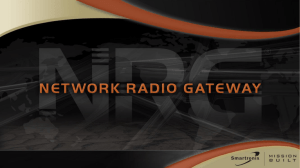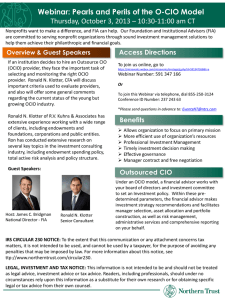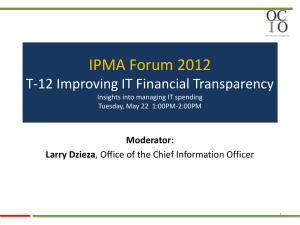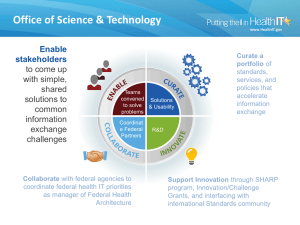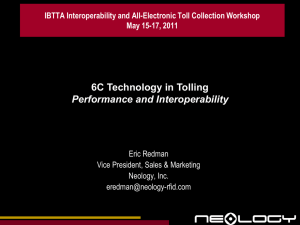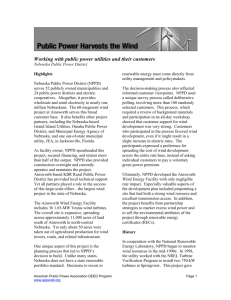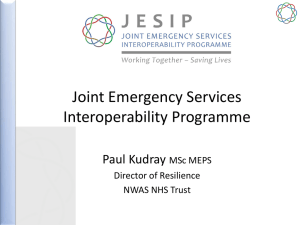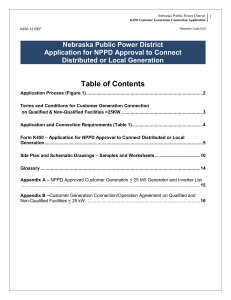PPT - Arizona APCO / NENA
advertisement
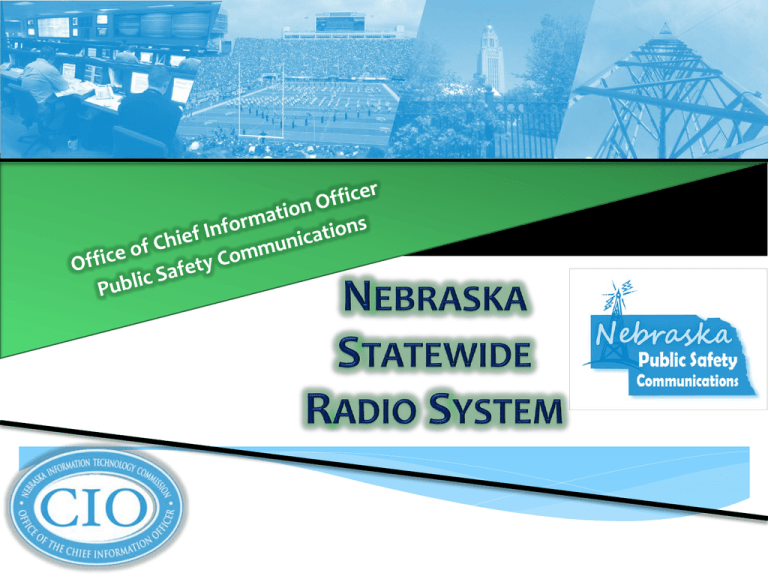
Building a Statewide Communication System, Partnerships, AND Interoperability from the ground up. State of Nebraska Office of the Chief Information Officer Public Safety Team What we’ll cover How We Accomplished… The Project The Partnerships The Interoperability Plan First (Expectations) It takes a cast of many to accomplish a successful system. It’s a big task to maintain focus and stick to the project scope. There can only be a few leaders. Implementing a communication system of any size is a large undertaking! The project: How we got started Define the purpose and get political support: Improving communications for state law enforcement. Improve technology, coverage, capacity, reliability. It’s not too difficult to understand the need. Set realistic objectives: State agencies would be the primary users initially. State would manage certain aspects of the project. MANAGE EXPECTATIONS – This will be a constant challenge! This gets a little trickier. What are the stated objectives and project scope? The project: How we got started Know your cost factors: Frequencies, licensing, tower infrastructure, remediation, network, subscriber equipment, facilities, personnel, maintenance, training, system lifecycle, ongoing support. Have a timeline: Obtaining the needed information (consultants, RFI, user input…) Assembling the interested parties Framing user agency requirements RFP process, evaluation, contract award, protests Implementing the system Project acceptance and final closeout Governor support and Legislature funded RFP in 2007 Contract award to Motorola in 2008 State and public power owned, managed, and maintained (the partnership started coming together during the RFP requirements) Green light! Funded and ready to go…now what? The project Building a plan: Hiring a consultant - Consultants are for advising, not deciding. You need a clear idea about your system, who the system will serve, a realistic scope, cost, timeline, and adjusting to unexpected change. Gathering the participants and relevant information: Participation by the user agencies Framing the RFP requirements Using your consultant’s input Coordinating with your purchasing agency The project Project Management: Working with multiple Project Managers (Motorola, State, NPPD) The Customer’s objective – a successful system and successful users The Vendor’s objective – win the contract, install the system, and get paid RULE #1: These objectives are NOT the same! (Although both want a successful outcome.) We divided ours and the vendor’s responsibilities and learned to coordinate. Business process ensures invoicing and payments are tracked. Technical process ensures implementation goes as planned and delays can be minimized. Joint PM ensures deliverables are met on both sides. We managed two project timelines to track progress and anticipate work flows. The project How we managed the process: Division of responsibilities and deliverables Avoiding the Blame Game Dealing with Conflicts, Negative media attention and the Politics. Coverage testing and the so-called “coverage guarantee.” Towers, network, frequencies, and system acceptance. There is no one way to do a system, but there are many common issues with all systems. Project closeout and tying up the loose ends The project 2 Master Switches: State location in Lincoln and NPPD location in Kearney DSR (dynamic system resiliency) 51 towers networked to the masters 6 state and 2 public power dispatch centers VHF multi-site trunked wide area roaming Digital “P25” radio standard Mobile VHF radios, portable 700/800 MHz radios 700 MHz DVRS extends portable coverage Make use of urban trunked 800 MHz systems for portable coverage The partnership Interest by NPPD, the state’s largest public power utility in joining the state project. They needed a new radio system too. Interest by the state OCIO in partnering to share the cost, ownership, management, and maintenance of the system. The partnership The result: Joining the state Office of the Chief Information Officer public safety team and Nebraska Public Power District telecommunication team to integrate system management. The partnership How we Manage the System: System Operating Group – Director level decisions System Administrative Group – System policy and operating decisions System User Group – User agency representation Partnerships are a lot of work but they work! The System User Group involves decision makers who understand their agency communications operations. The partnership Key principles: System User Group is an education forum and to discuss any issues deemed important by the users. Everyone takes responsibility for the issues under their control. No one gets to blame the process or the system or what is outside their control. Accountability for each agency’s responsibilities ensures everyone is getting the correct information. Problems are openly acknowledged and discussed. Solving problems takes understanding the process, and everyone understanding that it takes commitment, time and money. System management OCIO and NPPD have joint ownership and maintenance System Operating Group (SOG): State Chief Information Officer and NPPD Telecom Admin System Administrative Group (SAG): OCIO Public Safety and NPPD Telecom System User Group (SUG): All agencies using the system (local, state, federal) Lesson learned 1. Establish a Project leader and Coordinator. 2. Hire assistance to advise while forming the process. 3. There is no one system that fits everyone. You have to decide a starting point, stick to your plan. 4. Develop processes for policies and to continually improve the system and management. 5. Training and education for the users and dispatchers is hugely important. 6. The system is dispatch oriented. Training Training the users and dispatchers is THE biggest issue for success in any communication system. Partnering Cost model is a basic fee structure Consideration given for local enhancements to system Each partnership is taken case-by-case Accommodating local legacy systems Consolette radio on the local legacy console User radios for interoperability on the system Console upgrade to network on system Towers/facilities that may benefit the system. Interoperability on designated talk groups Flexibility to add agencies, consoles, towers, talk groups, capacity Partnering Sharing a system successfully lays the groundwork for creating other partnerships. How we are creating partnerships in the system Joint infrastructure ownership, management, and maintenance User Group of user representation Federal spectrum sharing Local access to the system Opportunities for investment in the system that meets user needs while growing participation in the system System sharing is what it’s about Evolving talk group planning Established subscriber unit planning Cost modeling…create a recipe for success attractive to adding new partners It’s more than creating a fee, it’s a creating a sustainable support plan, and the flexibility to consider what partners may be able to contribute Shared maintenance Maintenance of towers, generators, sites, network is all shared between state and NPPD OCIO and NPPD both support their respective networks NPPD sends the outage notifications to users agencies OCIO maintains 75% of the towers, NPPD owns 25% 50/50 cost share of the Motorola system Technicians can go to any site for system maintenance Internal vs vendor support services We buy software support, technical call-in, and security software All other needs we support internally between OCIO and NPPD Statewide mobile coverage Coverage Optimistic Coverage Map User perception Pessimistic Coverage Map User perception to Slightly Pessimistic Coverage Map User perception Noise value or budget to set coverage expectation. 12-15 dB noise not-to-exceed (issue is then vehicle not the system) Subscriber radios Creating a fleet map structure and shared talk groups Training and ongoing support for all users and dispatchers Dispatcher and user input Education on radio features Operational policies and field practice System statistics on user operation Education on system sharing between agencies Fleet map revisions and ongoing subscriber planning Assisting local agencies System orientation System use planning Explain costs Equipment options and guidance Ensure the plan fits the agency’s needs Public Safety Agencies POC = OCIO Public Utilities POC = NPPD Cost to join the system One-Time costs Purchase dispatch consoles & network connection Purchase user radios User equipment installation and programming Recurring costs Service Agreement with state OCIO Maintenance/repair/replacement dispatch consoles and radio equipment (radio service shop) Apply software patches/updates (radio service shop) Console network connection recurring fees (network provider) System Users State Patrol Nebraska Public Power District Lincoln Electric System State Fire Marshal’s Office Game and Parks Commission Department of Corrections Department of Roads Agriculture, Adult Parole, DEQ, DMV, NEMA… Lincoln County Sheriff and Emergency Manager FBI, US Marshal, ATF, US Fish & Wildlife Interoperability Interoperability is about having a plan that fits people. Start realistic, and simple is best. Don’t underestimate the time and training involved. Common mistakes: 1. Creating a plan for interoperability before testing it with the users and dispatchers. 2. NOT taking into account user and dispatcher feedback. “Interoperability without testing and training is a myth.” Interoperability The “ROC” talk group plan Orientation, training and testing provided at no cost No use fee One-Time costs Purchase consolette and/or user radios User equipment installation and programming Recurring costs Maintenance/repair/replacement radio equipment (radio service shop) Apply software patches/updates (radio service shop) Interoperability Shared talk groups Shared frequencies Regional Operations Common “ROC” talk groups. National interoperability frequencies “VTAC” “UTAC” 8TAC”… Testing other manufacturer P25 radios Working with multiple manufacturers to test their radios Provide expanded equipment options and pricing Ensure manufacturer support WSCA contract participating addenda Provide state expertise in programming radios Ensure problems are addressed with manufacturers Local radio shops Orientation for local radio shops Training and assistance to educate about the system We’re assisting radio shops and their technicians to understand: How their services support the system and its users The state process for their involvement The requirements for equipment installation, programming and testing Don’t just go buy a bunch of radios before talking with the OCIO about your intentions!!! Interoperability “ROC” Talk Groups Regional Operations Common (Based on Patrol troop areas) Interoperability H ROC CALL H ROC1 H ROC2 B ROC CALL B ROC1 B ROC2 Etc… Interoperability E ROC Call ROC talk groups at local dispatch console (In Patrol consoles and state radios also) Interoperability Partnerships Thanks!!! Mike Jeffres Public Safety Systems Manager Office of the CIO 501 S 14th Street Lincoln NE 68508 402-471-3719 mike.jeffres@nebraska.gov

